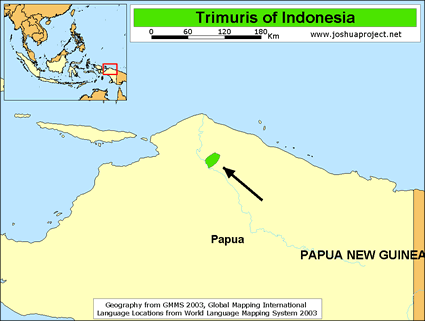The Trimuris, also referred to as the Trimuri or a subgroup of the broader Minahasa ethnic cluster, are an Austronesian people indigenous to the northern peninsula of Sulawesi, Indonesia, primarily inhabiting the transitional lowlands and coastal fringes of the Southeast Minahasa and North Minahasa Regencies, near villages such as Langoan, Remboken, and areas bordering Lake Tondano. Their name evokes "three villages" or "tri-muris," possibly alluding to ancient tripartite alliances of settlements that formed their core communities amid fertile volcanic plains and trade pathways. Origins link to proto-Austronesian migrations from Taiwan and the Philippines around the 13th century, where early settlers fused with local animistic groups to establish semi-autonomous walak (village-states) characterized by shared rice terraces and defensive pacts.
Pre-colonial Trimuris society thrived on communal farming and inter-village raids, including ritual headhunting to honor ancestors, within a landscape of frequent skirmishes that honed their warrior ethos. Animism dominated, with reverence for rice spirits and mountain deities guiding rituals.
The 16th century saw alliances formed to repel Spanish and Portuguese incursions, with unified coastal defenses repelling invaders. Dutch VOC traders arrived in the 17th century, introducing cloves and coffee plantations that integrated Trimuris into global commerce, while 19th-century missionaries accelerated Christianization, dismantling slavery and headhunting. By the 1830s, under the Minahasa Confederation—"to become one"—the Trimuris helped forge regional solidarity against Bolaang-Mongondow expansions, embracing Western education that positioned them as Indonesia's early elites.
Post-1949 independence, they navigated national unity, contributing to North Sulawesi's development while facing land pressures from urbanization and mining, yet retaining a distinct identity through linguistic and customary revivals.
The Trimuris inhabit a dynamic world of rolling hills and seaside hamlets, where ancestral rhythms of cooperation sustain families against modern tides. Work hinges on diversified agriculture, with households rotating labor groups to cultivate rice, maize, and nutmeg on nutrient-rich slopes, while coastal kin harvest seaweed, tuna, and clams; many adults balance this with urban pursuits in Manado's markets, fisheries processing, or eco-tourism guiding, fostering remittances that fund communal improvements.
Family structures follow patrilineal lines in extended compounds. Marriages seal bonds through elaborate church rites and bridewealth exchanges. Child upbringing emphasizes values of reciprocity—children learning through apprenticeships in fields and looms. Elders recite epics to weave moral tapestries.
Celebrations burst with fervor, centering on the June-September Pengucapan Syukur harvest festival, where torchlit processions to hilltop chapels feature kolintang bamboo orchestras. Lego-lego dances reenact creation myths, and effigy burnings symbolizing renewal. Christmas merges with ancestral toasts via saguer wine, and funerals span weeks with vigils, carved effigies, and feasts invoking guardian spirits.
Food pulses with coastal-earth fusion. For example, they eat a corn-rice porridge laced with prawns and greens. Coconut-stewed chicken or eel is seasoned with turmeric and chilies. Gohu is a lime-marinated raw fish salad. For dessert there is coconut custard and fermented bananas.
Most Trimuris follow their ancient, animistic beliefs. A minority follow Protestant Christianity, a transformation wrought by 19th-century Dutch and German missions that wove monotheism into their communal ethos, emphasizing redemption, stewardship, and fellowship over former spirit appeasements. This faith animates village life through vernacular sermons, prayer circles invoking Opo Empung (the High God), and church-led ethics that recast land guardianship as divine covenant. Pastors and elders fuse biblical parables with harvest liturgies, viewing creation as sacred mandate, while sanctuaries host moral deliberations and aid networks, with faint ancestral echoes in blessing rites.
Archival recording and school integration of the Trimuris dialect are imperative to stem its decline amid the rise of Manado Malay and Indonesian in daily discourse. Reinforcement of coastal land tenure against erosion and commercial aquaculture would preserve traditional fishing grounds vital for sustenance. Community health clinics equipped for tropical ailments and nutritional education would mitigate vulnerabilities, enhancing resilience in remote settlements.
Pray for vernacular Bible portions to spark fervent small-group studies, empowering Trimuris leaders to disciple others and to teach them to extend discipleship to other tribes.
Pray for family-wide awakenings that celebrate Christ.
Pray for harmonious evangelism with adjacent Muslim enclaves, cultivating dialogues rooted in shared humanity.
Pray for fortified seawalls and reforestation to shield farmlands from storms, ensuring steady yields.
Scripture Prayers for the Trimuris in Indonesia.
Wikipedia. "Minahasan people."
https://en.wikipedia.org/wiki/Minahasan_people
Encyclopedia.com. "Minahasans."
https://www.encyclopedia.com/humanities/encyclopedias-almanacs-transcripts-and-maps/minahasans-0
Cultural Survival. "We Come From Within the Land." https://www.culturalsurvival.org/publications/cultural-survival-quarterly/we-come-within-land
Gangga Island Resort & Spa.
"5 Things to Learn About the Minahasan People of North Sulawesi." https://www.ganggaisland.com/news/5-things-about-minahasan-north-sulawesi/
Facts and Details. "ETHNIC GROUPS ON SULAWESI." https://factsanddetails.com/indonesia/Minorities_and_Regions/sub6_3e/entry-4010.html
Britannica. "Minahasan."
https://www.britannica.com/topic/Minahasan
DBpedia. "About: Minahasan people."
https://dbpedia.org/page/Minahasan_people
Wikipedia. "North Sulawesi."
https://en.wikipedia.org/wiki/North_Sulawesi
| Profile Source: Joshua Project |











